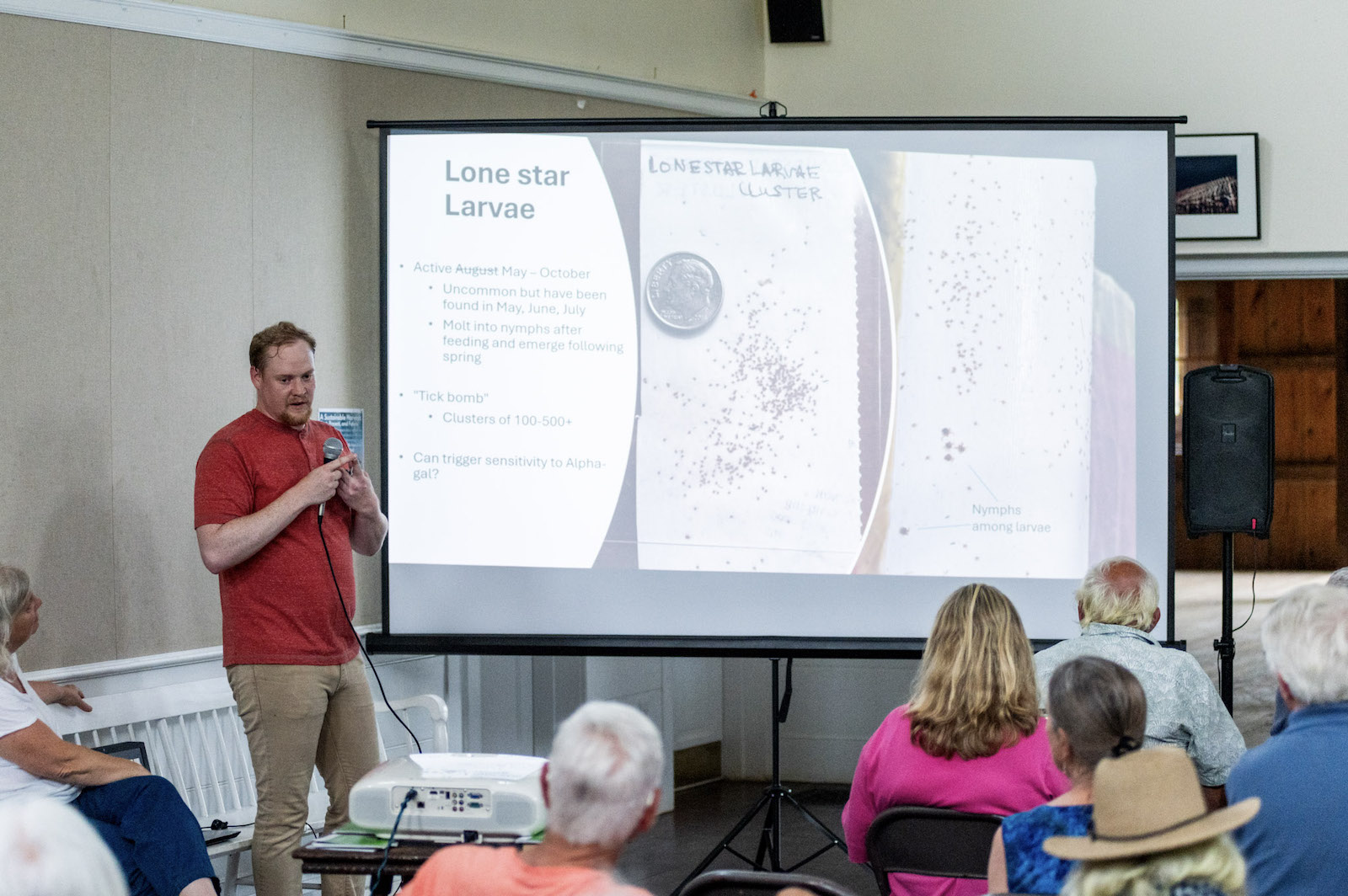Benadryl, hydrocortisone cream, prescription-only permethrin cream — all are in high demand at Conroy’s Apothecary in West Tisbury, where owner and pharmacist Tamara Hersh says that a wave of late summer tick and mite bites have sent Islanders into her store itching for relief.
“It started in August and has just exploded,” Ms. Hersh said.
Island wildlife experts, doctors and pharmacists have all reported a spate of tick and mite bites in recent weeks.
This time of year, the Island’s lone star and deer tick larvae emerge by the thousands, tick biologist Patrick Roden-Reynolds said. At the same time, nymph and adult ticks are dying or going dormant, so their bites are rare.
About the size of a speck of dirt, tick larvae can still cause extremely itchy bites, Mr. Roden-Reynolds said. Unlike adults or nymphs, tick larvae (especially lone star larvae) appear in clusters. Their bites often resemble a rash.
“I feel strongly that most people are suffering from larvae bites, tick larvae, whether it’s deer tick or lone star,” Mr. Roden-Reynolds said of the recent wave of bites. “It’s hard to like describe the actual bite, because other people will react differently.”
A handful of bites scattered across the ankles, leg and belly are indicative of deer tick larvae. Clusters of dozens of bites around the legs and ankles are likely due to the lone star ticks, which spend their larval stage in tight clusters that Mr. Roden-Reynolds calls “tick bombs.”
“You’ll literally just swipe up against something, and then you have hundreds of tick larvae on you at once.... It’s the number one way you kind of encounter lone star tick larvae is in these massive clusters,” Mr. Roden-Reynolds said.
In the first week of September, the hospital emergency room treated “approximately 20 cases of lesions that are consistent with tick larvae bites,” Dr. Ellen McMahon, the hospital’s chief of medicine, told the Gazette in a statement.
“These lesions are typically located on the legs, feet and ankles and are highly itchy. The bites are generally acquired in grassy areas, as the larvae ascend from the ground,” Dr. McMahon said.
Deer ticks, which carry Lyme disease and tularemia, are born sterile and their larval bites carry no risk of disease. However, both Dr. McMahon and Mr. Roden-Reynolds noted that bites from the lone star larvae can cause sensitization to alpha-gal syndrome, a tick-borne allergy to red meat. This is because lone star ticks, which carry the carbohydrate compound that triggers alpha-gal syndrome, are likely born with the compound in their saliva, Mr. Roden-Reynolds said.
As word of bites and rashes spread across social media, many Islanders suggested that their bites were caused by other biting arthropods, such as the oak mite or chigger, neither of which is known to be native to Martha’s Vineyard.
At the hospital, Dr. McMahon said they had “also encountered cases of oak mite irritation, though less frequently” than tick larvae bites.
“Oak mites are tiny arachnids (not insects) that are commonly found on oak trees and are difficult to see without magnification. These cases are usually linked to activities such as gardening or working with oak trees,” Dr. McMahon said.
Mr. Roden-Reynolds noted that oak mites drop from oak trees onto the necks, shoulders and backs of those underneath, and so their bite pattern differs from tick larvae, which concentrate around the legs and ankles.
Other Islanders reported being bitten by chiggers, another microscopic arthropod not native to the Vineyard.
Dr. Sam Telford of Tufts has studied the expansion of the chigger population northward into New England from its mid-Atlantic and southern range. In an email, Dr. Telford wrote that he had observed chiggers in New England and spoken with a small handful of Islanders who he believed had suffered from chigger bites.
Dr. Telford stressed that, regardless of any chigger bites that may be identified on the Island, the most likely culprit for the recent wave of bites is tick larvae.
Claire Seguin, chief nursing officer and vice president of operations at the hospital, said that Islanders should take precautions when spending time outdoors in the coming weeks.
“For oak mites, reducing exposure by avoiding oak trees or using insect repellents may help. For tick larvae, wearing long sleeves and pants in tick-infested areas and using tick repellents can reduce the risk of bites and associated diseases,” Ms. Seguin said.








Comments (8)
Comments
Comment policy »